Tach . 12, 2024 21:00 Back to list
dust seal vs oil seal
Dust Seal vs. Oil Seal A Comprehensive Comparison
In the world of machinery and engineering, seals play a pivotal role in ensuring the optimal performance and longevity of components. Among various types of seals, dust seals and oil seals are two of the most commonly utilized. While both serve the critical function of protecting machinery from contaminants, they are designed for different applications and environments. This article explores the key differences and applications of dust seals and oil seals, aiding in understanding their respective roles in machinery.
What is a Dust Seal?
A dust seal, as the name suggests, is designed primarily to prevent dirt, dust, and other particulates from entering a mechanical assembly. Typically used in areas exposed to external elements, dust seals are crucial in applications where particulate contamination can lead to wear and failure of components. Commonly made from materials such as rubber, polyurethane, or silicone, dust seals can be found in various machinery, including automotive, industrial equipment, and home appliances.
One of the predominant features of dust seals is their ability to function effectively in a wide range of temperatures and conditions. They are often designed to be resilient against the harsh conditions faced in outdoor environments. In summary, a dust seal primarily focuses on keeping external contaminants out of an assembly, thereby preserving the cleanliness and functionality of the internal components.
What is an Oil Seal?
Oil seals, on the other hand, are tasked with preventing the leakage of lubricants, such as oil or grease, from internal components. They not only serve as a barrier to retain lubricants but also assist in preventing external contaminants from entering the machinery. Oil seals are crucial for maintaining the integrity of lubricated parts, ensuring smooth operation and minimizing wear.
dust seal vs oil seal

Typically made from materials that can withstand petrochemical exposure, oil seals are usually crafted from rubber compounds, such as nitrile or Viton. Their design includes a lip that makes contact with a rotating shaft, providing a tight seal to prevent both leakage of oil and ingress of dirt. Oil seals can be found in applications ranging from automotive engines to industrial machinery and hydraulic systems.
Key Differences
1. Primary Function - Dust seals are designed primarily to keep dirt and debris out, while oil seals focus on retaining lubrication and preventing oil leaks. 2. Design and Construction - Dust seals are generally simpler in design, as they do not require a sealing lip that touches a shaft. In contrast, oil seals have specific lip designs that create a friction seal against rotating shafts.
3. Material Considerations - While both types of seals can be made from rubber, oil seals require materials that resist deterioration from oil exposure, which may not be necessary for dust seals. Dust seals often utilize flexible, durable materials that can withstand varying temperatures.
4. Applications - Dust seals are commonly found in equipment exposed to open air, such as bicycles, electrical enclosures, and machinery used in construction. Oil seals are more prevalent in enclosed systems where lubrication is vital, such as engines, gearboxes, and pumps.
Conclusion
Choosing the right seal is imperative for ensuring the longevity and efficiency of any mechanical system. Understanding the distinct functions of dust seals and oil seals is essential for engineers and technicians in selecting the appropriate sealing solutions for their specific applications. While dust seals protect internal components from external contaminants, oil seals maintain the crucial lubrication needed for smooth machinery operation. In many systems, both types of seals may be employed to provide comprehensive protection against the elements, thereby enhancing the overall performance and reliability of the equipment. By making informed decisions regarding seal types, users can significantly reduce maintenance costs and extend the lifespan of their machinery.
-
TCN Oil Seal Metal Ring Reinforcement for Heavy Machinery
NewsJul.25,2025
-
Rotary Lip Seal Spring-Loaded Design for High-Speed Applications
NewsJul.25,2025
-
Hydraulic Cylinder Seals Polyurethane Material for High-Impact Jobs
NewsJul.25,2025
-
High Pressure Oil Seal Polyurethane Coating Wear Resistance
NewsJul.25,2025
-
Dust Proof Seal Double Lip Design for Construction Equipment
NewsJul.25,2025
-
Hub Seal Polyurethane Wear Resistance in Agricultural Vehicles
NewsJul.25,2025
-
The Trans-formative Journey of Wheel Hub Oil Seals
NewsJun.06,2025
Products categories
















